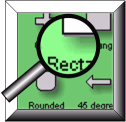|
|
Visio 2002® Developer's Survival Pack |
|
|
|
Visio 2002 Developer's Survival Pack is a book for developers
using Microsoft Visio® as a platform for building diagrammatic software
applications for business, I.T., science and engineering. Accompanying
software tools and samples provide crucial views inside Visio, and also for the
first time make easy the building of powerful "VSL" components using Visual
Basic.
| "Graham Wideman greatly expands his in-depth coverage of Visio solution development with an extended discussion of solution architecture, and a toolbox full of crucial tools for inspecting Visio's internals." -- Lori Pearce, General Manager, Microsoft Visio |
|
|
| Special note on where to order if you are in a hurry: A number of customers have noted that ordering through Amazon can be slow. This is because Amazon's interface to print-on-demand vendors is not as efficient as it might be. Other online vendors may be faster, and I'm happy for you to order from them. However, Trafford will be among the fastest -- please don't let the "foreign location" put you off. Reader Avi N in Israel was experiencing delay from "big name" vendor, and after ordering from Trafford, emailed me to say: "You were right. Book arrived today. Can trust Canadians :-)". | |
Developers seeing opportunities to leverage Microsoft Visio's programmable diagramming environment need to be able to design and build their applications quickly and sure-footedly -- achieving business-serving results in a business-compatible timeframe.
To that end, this book and set of tools is organized around the premise that developers will have the following interests and needs:
 |
Visio Structure: An organized and comprehensive
presentation of Visio's document and user-interface object models including
the all-important ShapeSheet.
Browsable Reference Material: There's lots of info in Visio's Developer Help, but it will take you forever to digest enough of it to get the big picture. To greatly accelerate the process, this book includes a "browsable" reference section -- objects, properties, methods and shapesheet cells and functions tabulated in an order which brings related items together. You'll still use Help, but with this book you can rapidly skim over and locate features of interest to your task at hand. |
 |
Visio Behavior: The power beneath the surface. Work with it, not against it! Investigation of numerous key areas of Visio behavior, at a level which uncovers many subtleties not evident from simply using the product. |
 |
Solution Architectures for adding functionality to
Visio. Several alternative forms are possible. Read why "VSL Addons" are
still the preferred form for many kinds of application. VSLs have
traditionally required C/C++, Delphi, or some other language capable of
working with Automation and producing arbitrary DLLs. Now, using the
"VBVSL_Adapter" component available with this book, VSLs can be built easily
with Visual Basic. The VBVSL foundation allows the book to use Visual Basic samples to illuminate many more topics of interest to Visio-based application-builders. Several sample applications are supplied which you can copy and modify to get your own addons up and running quickly. |
 |
Browsing Tools: The book gives you access to
download a suite of browsing tools which you can use to instantly clarify
exactly what's going with several of Visio's more elaborate or arcane
features, such as EventLists, UIObjects, CommandBars, browse Visio 2002's
new XML-format files and so on. This will vastly accelerate
your learning process, and goes a long way to keep your development efforts
on track. |
Inevitably, there is some overlap between the new book and my previous one. Of the "foundation" chapters that are similar in the new book, each one has been updated to reflect changes in Visio, bugs fixed (and opportunities thereby enabled), and the new browsing tools are integrated where they apply. The material on building additional functionality is "All New!".
As in many previous releases of Visio, the Visio group is releasing a publication called "Developing Visio Solutions". This will appear online in the MSDN documentation tree, and (I've been told) will be available in print form from Microsoft Press (hence in some bookstores). DVS also includes some software samples and components that may be of use to developers.
2002-08-08 Update: Developing Visio Solutions is available online in
the msdn library tree at:
Office Solutions Development
Microsoft Visio
SDK Documentation
whose URL is currently: link
Visio 2002 Developer's Survival Pack (V2002DSP) avoids duplicating a lot of great material that's in DVS, since readers can easily get that for free. While DVS does a great job on introducing all the Visio programming basics (how to use the ShapeSheet, Automation programming with VBA etc), V2002DSP builds beyond that to focus on the needs of developers at intermediate-to-advanced levels.
If you are completely unfamiliar with Visio's ShapeSheet, or with VBA and Automation, you'll definitely need DVS. If you are already familiar with Visio as a user, comfortable with basic ShapeSheet ideas and Automation programming in general, then V2002DSP will help you rapidly consolidate your understanding of Visio structure and behavior.
When you want to start building additional functionality, you'll definitely want to consider V2002DSP's solution architecture coverage. Just the discussions of the new Addins vs VSL Addons, and the new CommandBars vs UIObjects, will save you significant detours if considered early in your development process.
I have over 25 years of experience in electrical engineering, software development, information systems, business analysis and conceptual modeling. In each of these disciplines I mastered the formal diagrams, yet in addition I always found the need to generate drawings automatically, and to extend each diagrammatic convention in formal or informal ways to convey richer sets of detail- or summary-level concepts.
Partly to that end, I have been building solutions and tools with diagramming libraries and environments for ten years, and with Visio for over five years. I am also affiliated with the SemNet group centered as San Diego State University. Over the last 15 years this group has produced basic tools for diagramming general semantic networks and formally studying the teaching and learning benefits in making concepts and relationships explicit.
Since my first Visio book (Visio 2000 Developer's Survival Guide) I have enjoyed developing a number of new relationships with people in the Visio business, both inside and outside Microsoft.... several of which have contributed much to the book described here.
You may sometimes find me on the Visio newsgroups at msnews.microsoft.com. I have been recognized for spending way too much time on Visio with a Microsoft Valued Professional (MVP) award.
Downloads and Supporting Info for Book Owners |
The several tools and many samples are available to book owners for download here. Updated 2002-08-15
Microsoft and Visio are either registered trademarks or trademarks of Microsoft Corporation in the United States and/or other countries.
Article Created: 2001-05-01 Last edit: Last edit:
03-10-15 Graham
Wideman
Go to:
DiagramAntics.com